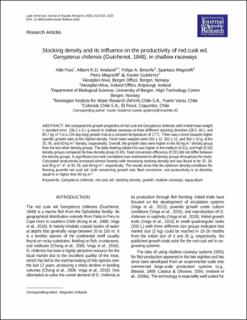Stocking density and its influence on the productivity of red cusk eel, Genypterus chilensis (Guichenot, 1848), in shallow raceways
| dc.contributor.author | Foss, Atle | |
| dc.contributor.author | Imsland, Albert | |
| dc.contributor.author | Briceño, Felipe A. | |
| dc.contributor.author | Magnolfi, Spartaco | |
| dc.contributor.author | Magnolfi, Piero | |
| dc.contributor.author | Gutiérrez, Xavier | |
| dc.date.accessioned | 2021-07-05T07:03:53Z | |
| dc.date.available | 2021-07-05T07:03:53Z | |
| dc.date.created | 2021-01-16T17:30:44Z | |
| dc.date.issued | 2020 | |
| dc.identifier.issn | 0718-560X | |
| dc.identifier.uri | https://hdl.handle.net/11250/2763258 | |
| dc.description.abstract | We compared the growth properties of red cusk eel Genypterus chilensis with initial mean weight ± standard error, 106.2 ± 6.1 g reared in shallow raceways at three different stocking densities (28.5, 46.1, and 60.7 kg m-3) in a 226-day long growth trial at a constant temperature of 17°C. There was a trend towards higher specific growth rates at the highest density. Final mean weights were 333 ± 12, 352 ± 12, and 354 ± 15 g, at the 30, 45, and 60 kg m-3 density, respectively. Overall, the growth rates were higher in the 60 kg m-3 density group than the two other density groups. The daily feeding intake (%) was higher in the medium (0.51), and high (0.55) density groups compared the low-density group (0.45). Feed conversion efficiency (FCE) did not differ between the density groups. A significant size rank correlation was maintained in all density groups throughout the study. Calculated productivity increased almost linearly with increasing stocking density and was found to be 32, 34, and 39 g m-2 d-1 at 30, 45, and 60 kg m-3, respectively. The results show that the optimum density conditions for farming juvenile red cusk eel, both concerning growth rate, feed conversion, and productivity is at densities equal to or higher than 60 kg m-3. | en_US |
| dc.language.iso | eng | en_US |
| dc.publisher | Pontificia Universidad Católica de Valparaíso | en_US |
| dc.title | Stocking density and its influence on the productivity of red cusk eel, Genypterus chilensis (Guichenot, 1848), in shallow raceways | en_US |
| dc.type | Journal article | en_US |
| dc.type | Peer reviewed | en_US |
| dc.description.version | publishedVersion | en_US |
| cristin.ispublished | true | |
| cristin.fulltext | original | |
| cristin.qualitycode | 1 | |
| dc.identifier.doi | 10.3856/vol48-issue5-fulltext-2528 | |
| dc.identifier.cristin | 1872542 | |
| dc.source.journal | Latin American Journal of Aquatic Research | en_US |
| dc.source.pagenumber | 818-825 | en_US |
| dc.identifier.citation | Latin American Journal of Aquatic Research. 2020, 48 (5), 818-825. | en_US |
| dc.source.volume | 48 | en_US |
| dc.source.issue | 5 | en_US |
Tilhørende fil(er)
Denne innførselen finnes i følgende samling(er)
-
Department of Biological Sciences [2289]
-
Registrations from Cristin [10402]
